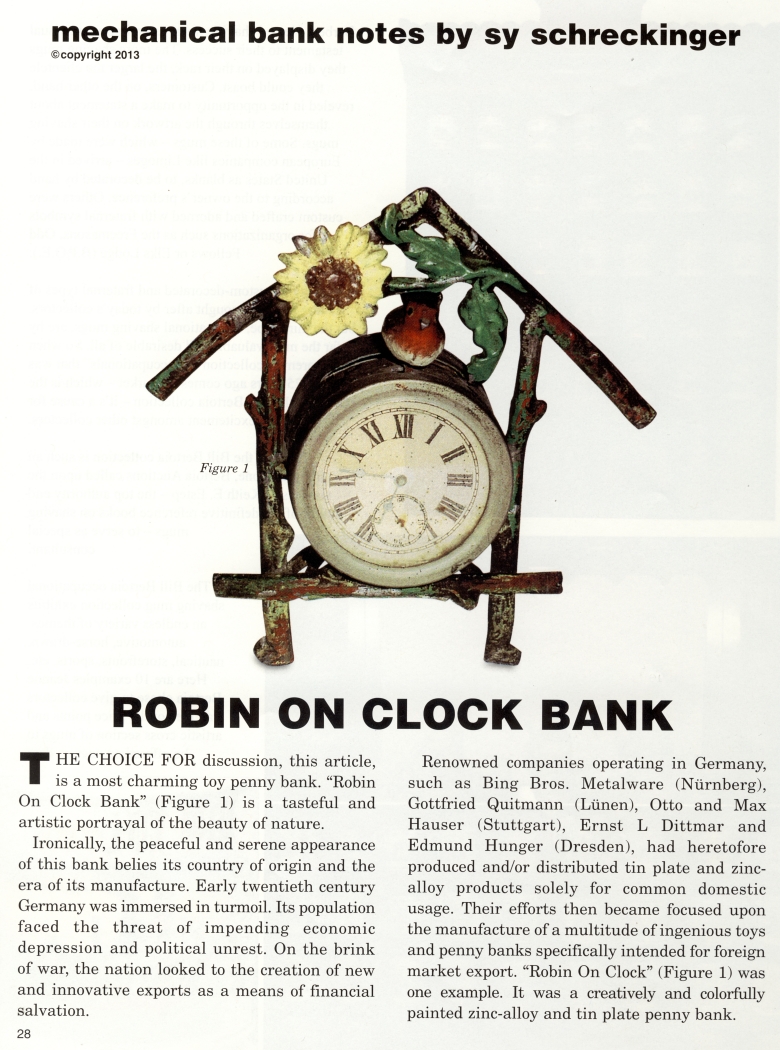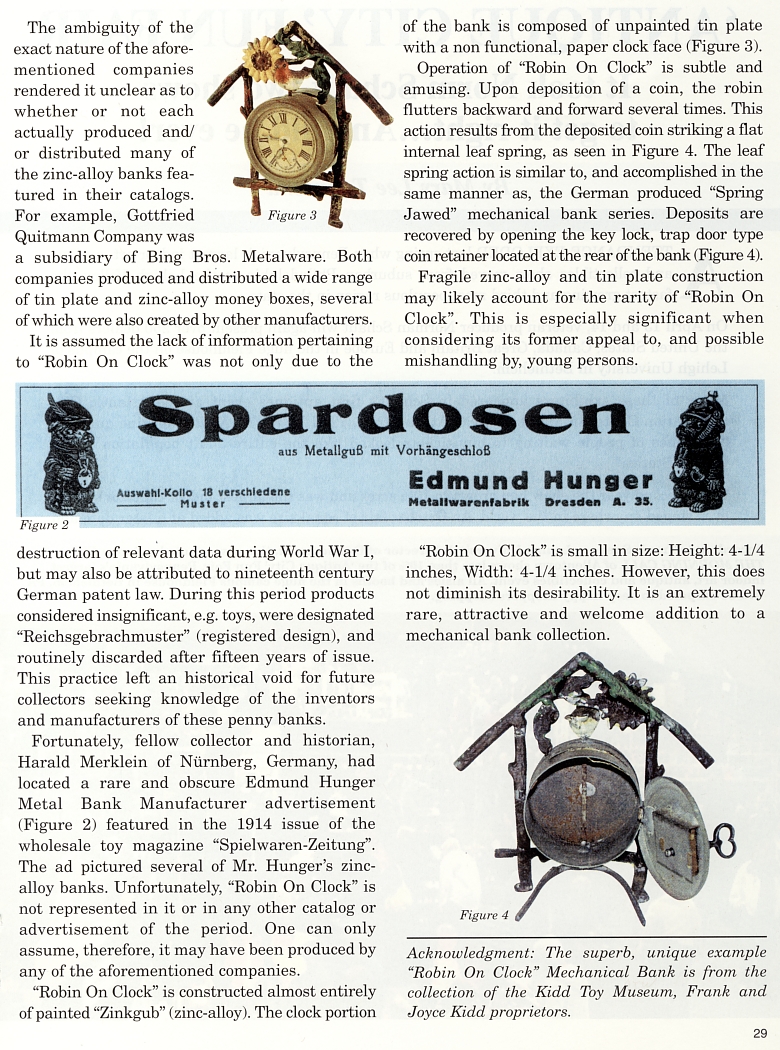|
ROBIN ON CLOCK
by Sy Schreckinger – ANTIQUE TOY WORLD Magazine –
April, 2013
THE
CHOICE FOR discussion, this article, is a most charming toy penny bank.
"Robin On Clock Bank" (Figure 1) is a tasteful and artistic portrayal of
the beauty of nature.
Ironically, the peaceful and serene appearance of this bank belies
its country of origin and the era of its manufacture. Early twentieth
century Germany was immersed in turmoil. Its population faced the threat
of impending economic depression and political unrest. On the brink of
war, the nation looked to the creation of new and innovative exports as
a means of financial salvation.
Renowned companies operating in Germany, such as Bing Bros.
Metalware (Nurnberg), Gottfried Quitmann (Lunen), Otto and Max Hauser
(Stuttgart), Ernst L Dittmar and Edmund Hunger (Dresden), had heretofore
produced and/or distributed tin plate and zinc-alloy products solely for
common domestic usage. Their efforts then became focused upon the
manufacture of a multitude of ingenious toys and penny banks
specifically intended for foreign market export. "Robin On Clock"
(Figure 1) was one example. It was a creatively and colorfully painted
zinc-alloy and tin plate penny bank.
The ambiguity of the exact nature of the aforementioned companies
rendered it unclear as to whether or not each actually produced and/ or
distributed many of the zinc-alloy banks featured in their catalogs. For
example, Gottfried Quitmann Company was a subsidiary of Bing Bros.
Metalware. Both companies produced and distributed a wide range of tin
plate and zinc-alloy money boxes, several of which were also created by
other manufacturers.
It is assumed the lack of information pertaining to "Robin On
Clock" was not only due to the destruction of relevant data during World
War I, but may also be attributed to nineteenth century German patent
law. During this period products considered insignificant, e.g. toys,
were designated "Reichsgebrachmuster" (registered design), and routinely
discarded after fifteen years of issue. This practice left an historical
void for future collectors seeking knowledge of the inventors and
manufacturers of these penny banks.
Fortunately, fellow collector and historian, Harald
Merklein of Nurnberg, Germany, had located a rare and obscure Edmund
Hunger Metal Bank Manufacturer advertisement (Figure 2) featured in the
1914 issue of the wholesale toy magazine "Spielwaren-Zeitung". The ad
pictured several of Mr. Hunger's zinc- alloy banks. Unfortunately,
"Robin On Clock" is not represented in it or in any other catalog or
adsement of the period. One can only assume, therefore, it may have been
produced by any of the aforementioned companies.
"Robin On Clock" is constructed almost entirely of painted "Zinkgub"
(zinc-alloy). The clock portion of the bank is composed of unpainted tin
plate with a non functional, paper clock face (Figure 3).
Operation of "Robin On Clock" is subtle and amusing. Upon
deposition of a coin, the robin flutters backward and forward several
times. This action results from the deposited coin striking a flat
internal leaf spring, as seen in Figure 4. The leaf spring action is
similar to, and accomplished in the same manner as, the German produced
"Spring Jawed" mechanical bank series. Deposits are recovered by opening
the key lock, trap door type coin retainer located at the rear of the
bank (Figure 4).
Fragile zinc-alloy and tin plate construction may likely account
for the rarity of "Robin On Clock". This is especially significant when
considering its former appeal to, and possible mishandling by, young
persons.
"Robin On Clock" is small in size: Height: 4-1/4 inches, Width:
4-1/4 inches. However, this does not diminish its desirability. It is an
extremely rare, attractive and welcome addition to a mechanical bank
collection.
Acknowledgment: The superb, unique example "Robin On Clock"
Mechanical Bank is from the collection of the Kidd Toy Museum, Frank and
Joyce Kidd proprietors. |

